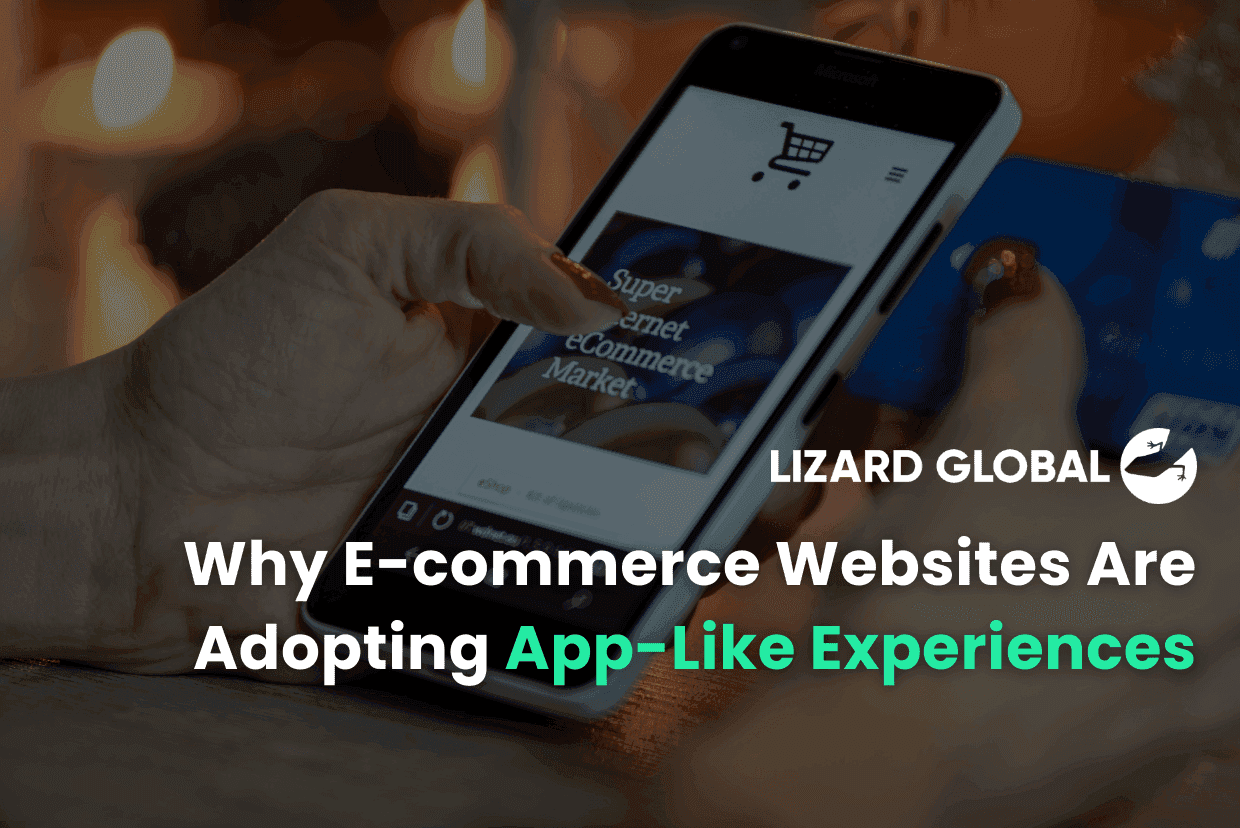Data protection
Data Security
+ 4 more ...
5 Ways to Secure Your Application
12 Aug 2025
by Author - Lotte, Digital Content Specialist, Editor - Nadiy, Senior Content Writer
12 Aug 2025
by Author - Lotte, Digital Content Specialist, Editor - Nadiy, Senior Content Writer
Data protection
Data Security
Cybersecurity
Encryption
Software Development
Mobile App Development
5 Ways to Secure Your Application
Table of contents
Contact us
We will get back to you in the next 48 hours.
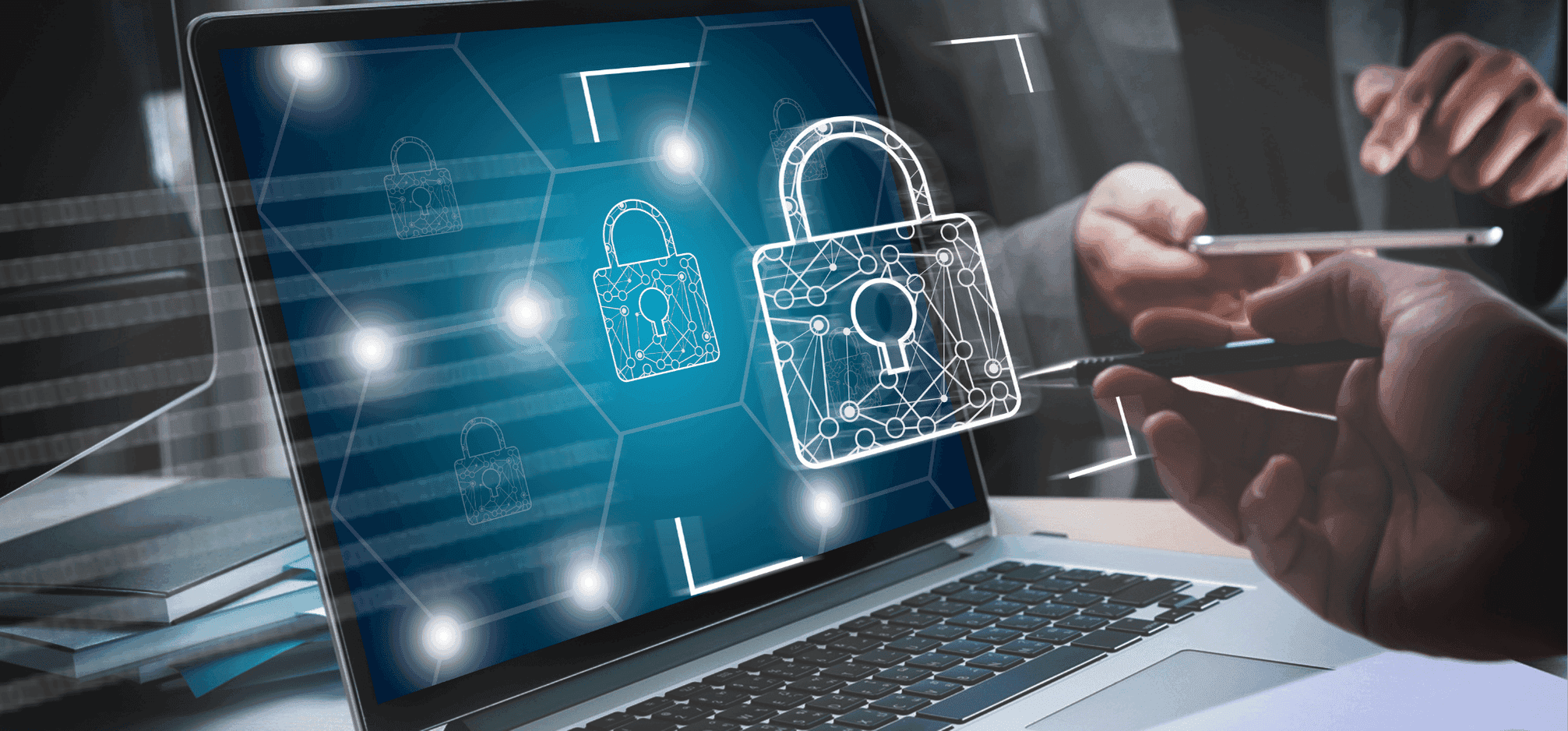
5 Ways to Secure Your Application
Keep your app out of hackers crosshairs with 5 practical, developer-friendly tactics that fortify data protection. Software developers make use of these 5 ways to secure the personal data in your application.
key takeaways
The security of your application is key, especially now more and more of our personal information is requested and stored online. As users of these applications, we want to make sure that our personal data is stored securely, fully protected against the risk of breaches and leaks.
Today, cybersecurity has become a major topic on the agenda of social media platforms, especially after Facebook’s multiple data privacy scandals, and their takeover of the popular messaging platform WhatsApp.
But not only have we been more cautious about the handling of our data on social media platforms, more and more software developers have specialized in developing applications with a close eye on data security.
Here are 5 ways software developers make sure your application is protected and safe.
1. Write and test secure code
During the process of writing code, app developers keep the protection of your data front of mind. Every piece of code is written on a foundation of safety and security. Any bugs and other vulnerabilities in code can already form a safety risk and a potential goal for attackers and hackers.
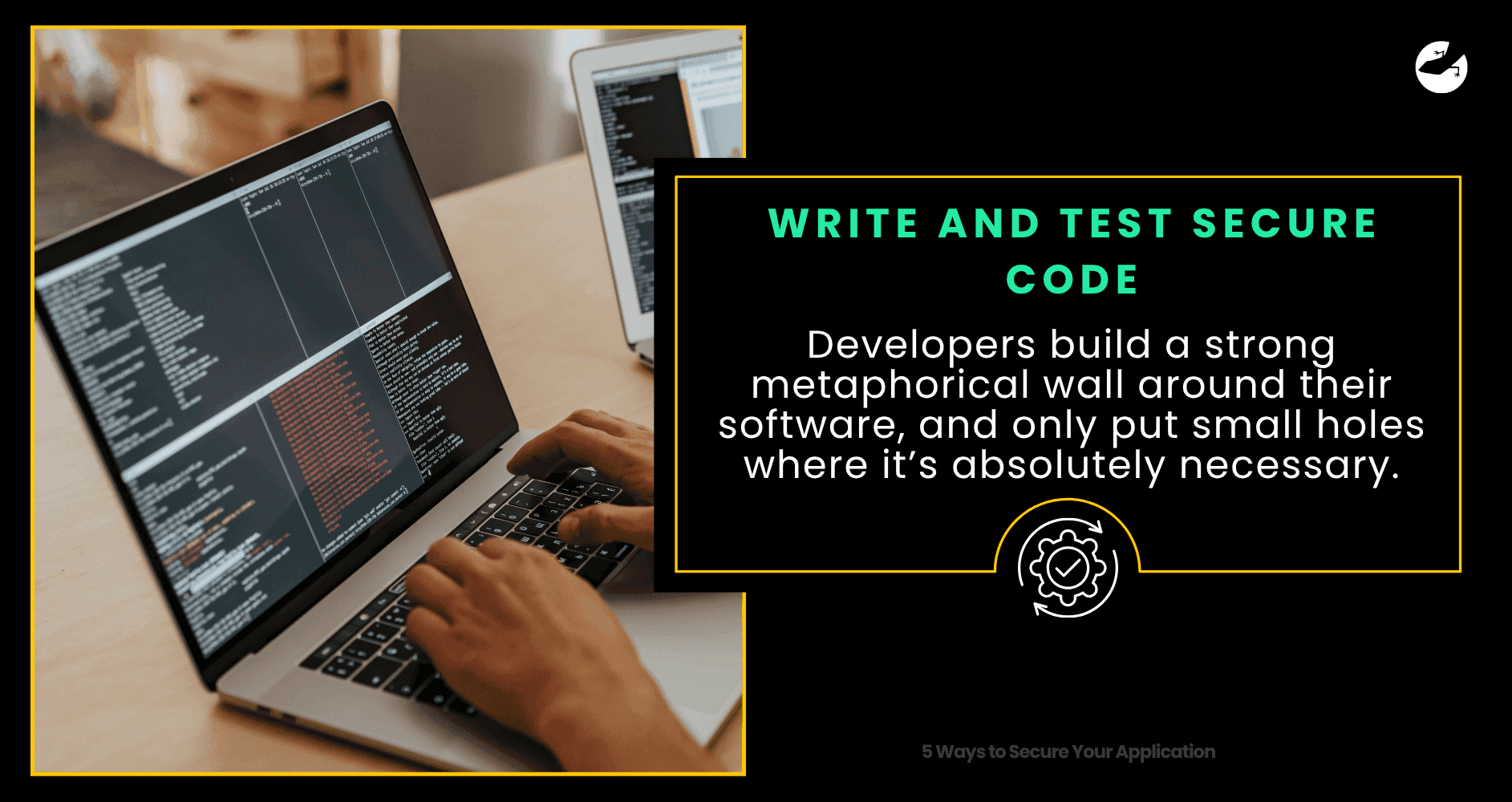
Generally, software developers follow the principles of privacy by design. This refers to the way they design and develop their applications in such a way that it guarantees a safe handling of user data.. They build a strong metaphorical wall around their software, and only put small holes where it’s absolutely necessary.
And even when necessary holes are made, they are designed and developed to be as safe and secure as possible. This way, developers can guarantee security by default.
2. Data Encryption
An increasing number of applications, and messaging platforms in particular, make use of data encryption, which allows users to digitally communicate with one another without the risk of interfering parties accessing their data.
How does that work? When user A decides to send a message to user B, the transferred message uses a public encryption key to turn the contents into random numbers, signs and letters when it leaves the device of user A and arrives at the server.
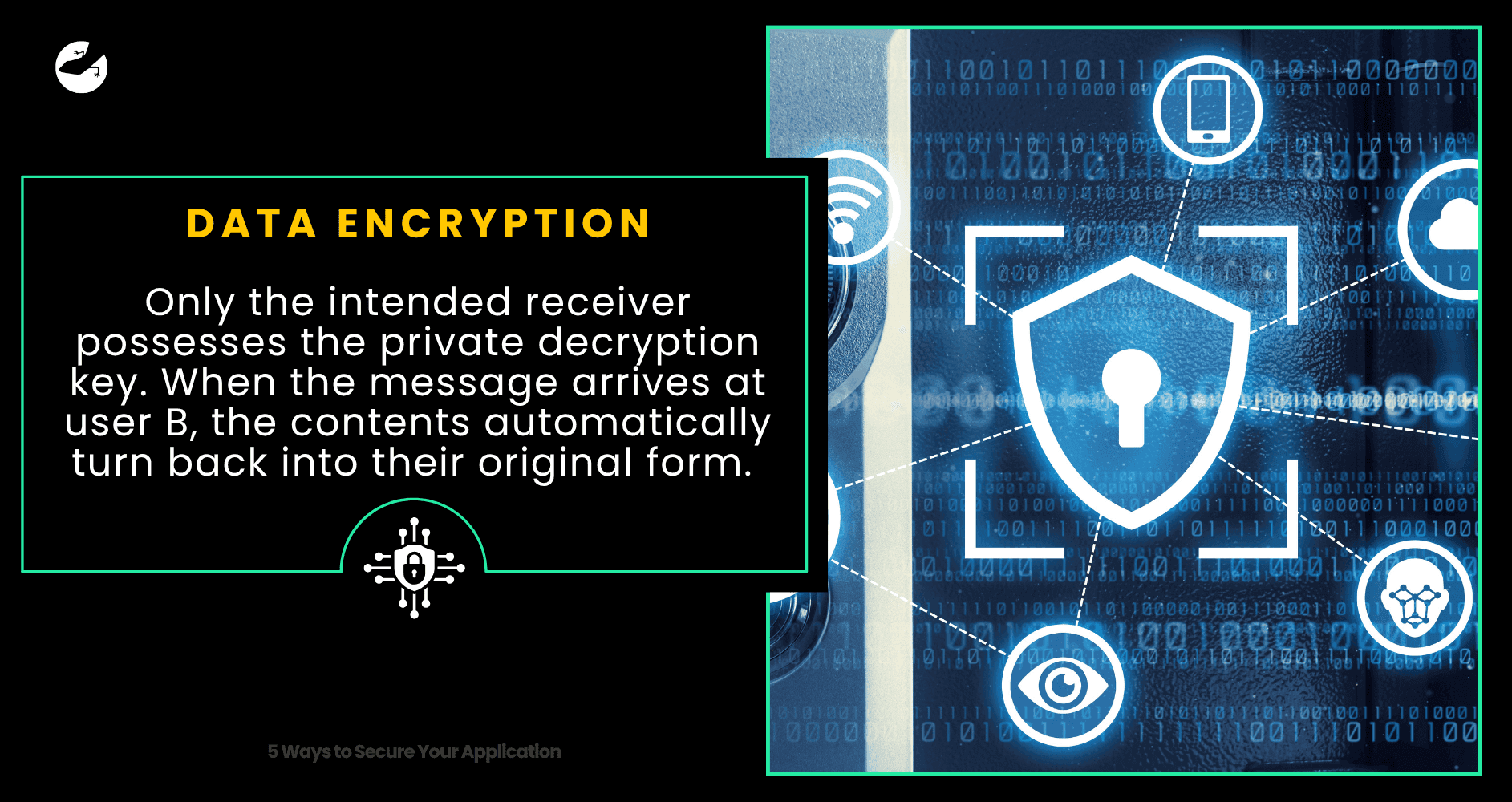
Even if someone manages to break into the server and retrieve your message, they will be unable to read it. Only the intended receiver possesses the private decryption key. When the message arrives at user B, the contents automatically turn back into their original form. This type of encryption is called “end-to-end encryption”, and is an efficient way to secure online communication.
As a user, you notice nothing of the whole process of encrypting and decrypting. This all happens automatically, without you having to worry about strangers having a peek through the messages and images you’ve sent to your friends and family.
3. Authorized and secured APIs
An API, or Application Programming Interface, is a software intermediary that allows two applications to communicate with each other. This way, developers can, for example, implement a “Share” button in their app, for users to share content with their friends on Facebook.
Some APIs aren’t securely authorized or are loosely coded, which allows hackers to access and misuse user data. To make sure an API can’t be misused by anyone, it often requires an API key.
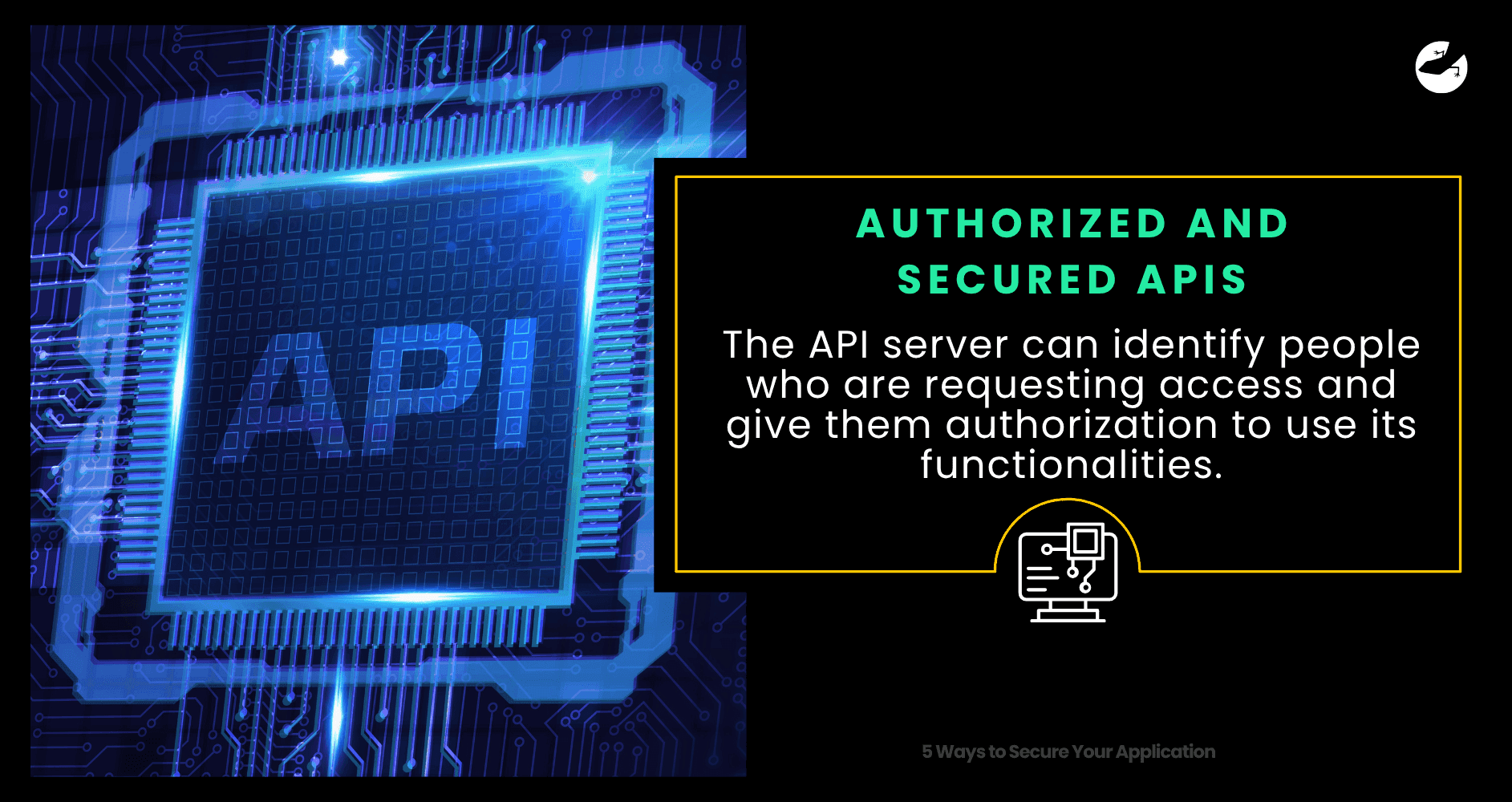
This way, the API server can identify people who are requesting access and give them authorization to use its functionalities. To optimize the security of your personal data, programmers make sure that the APIs they use are authorized and safe.
Want to find out how much it costs to build your dream app or web app?
4. High-level authentication
Many applications require users to register for a personal account, requiring users to login with a password and username in order to access their data. The stronger the authentication, the safer your data.
Although users are the people who are responsible for choosing a safe password, developers can also encourage their users to improve their authentication. For example, some applications require a minimum amount of letters, numbers, and symbols before accepting a password, or they ask users to renew their passwords every so often, and disallow the use of a previously used password.

Besides passwords, developers are also making use of technological innovations for high-level authentication. For example, logging in with a fingerprint or facial recognition technologies can immensely improve the security of an application.
2FA, or two-factor authentication is another safe way of identifying a user. It’s a security system that requires two forms of authentication before being able to access something. For example, Google requires users to fill in their passwords when accessing their account, but also frequently uses a second step that requires users to fill in a personal code they received in a message on their phone.
This way, if someone manages to obtain your password, he or she will still be unable to access your account.
5. Privacy by Design with limited privileges
Sometimes, an application doesn’t need that much personal information from users to function properly. Developers can make sure the application they build only requests information that’s necessary for the app to function.

After all, the more personal information a user shares with an application, the more user data can be accessed and misused in case of a security breach. This is called The principle of least privilege, or privacy by design, and dictates that a piece of code should only make use of the permissions it requires to function, and nothing more. If an app doesn’t need access to a user’s contacts, it shouldn’t ask for it.
Secure Solutions at Lizard Global
At Lizard Global, our developers are specialized in making sure your application is heavily protected. Not only do our developers work agile, they also use the most recent technologies to make sure all user data is safe and sound. This way, we continuously monitor the safety of your app, and immediately implement changes in code when the risk of data breaches has increased. However, we always aim to create applications that avoid the risk of data leaks in the first place.
We do this by focusing on the following key aspects:
- Confidentiality: only those with access rights can view privileged content
- Integrity: only those with authorization can access and/or amend the system’s content
- Availability and transparency: information will always be available to authorized users of the system

Want to know more about how we make sure your data is safe at all times? Check out our Secure Solutions, and don’t hesitate to get in touch with us if you have questions, or if you’re interested in a partnership with Lizard Global.
Join 2000+ subscribers
Stay in the loop with everything you need to know

5 Ways to Secure Your Application
Keep your app out of hackers crosshairs with 5 practical, developer-friendly tactics that fortify data protection. Software developers make use of these 5 ways to secure the personal data in your application.
The security of your application is key, especially now more and more of our personal information is requested and stored online. As users of these applications, we want to make sure that our personal data is stored securely, fully protected against the risk of breaches and leaks.
Today, cybersecurity has become a major topic on the agenda of social media platforms, especially after Facebook’s multiple data privacy scandals, and their takeover of the popular messaging platform WhatsApp.
But not only have we been more cautious about the handling of our data on social media platforms, more and more software developers have specialized in developing applications with a close eye on data security.
Here are 5 ways software developers make sure your application is protected and safe.
1. Write and test secure code
During the process of writing code, app developers keep the protection of your data front of mind. Every piece of code is written on a foundation of safety and security. Any bugs and other vulnerabilities in code can already form a safety risk and a potential goal for attackers and hackers.

Generally, software developers follow the principles of privacy by design. This refers to the way they design and develop their applications in such a way that it guarantees a safe handling of user data.. They build a strong metaphorical wall around their software, and only put small holes where it’s absolutely necessary.
And even when necessary holes are made, they are designed and developed to be as safe and secure as possible. This way, developers can guarantee security by default.
2. Data Encryption
An increasing number of applications, and messaging platforms in particular, make use of data encryption, which allows users to digitally communicate with one another without the risk of interfering parties accessing their data.
How does that work? When user A decides to send a message to user B, the transferred message uses a public encryption key to turn the contents into random numbers, signs and letters when it leaves the device of user A and arrives at the server.

Even if someone manages to break into the server and retrieve your message, they will be unable to read it. Only the intended receiver possesses the private decryption key. When the message arrives at user B, the contents automatically turn back into their original form. This type of encryption is called “end-to-end encryption”, and is an efficient way to secure online communication.
As a user, you notice nothing of the whole process of encrypting and decrypting. This all happens automatically, without you having to worry about strangers having a peek through the messages and images you’ve sent to your friends and family.
3. Authorized and secured APIs
An API, or Application Programming Interface, is a software intermediary that allows two applications to communicate with each other. This way, developers can, for example, implement a “Share” button in their app, for users to share content with their friends on Facebook.
Some APIs aren’t securely authorized or are loosely coded, which allows hackers to access and misuse user data. To make sure an API can’t be misused by anyone, it often requires an API key.

This way, the API server can identify people who are requesting access and give them authorization to use its functionalities. To optimize the security of your personal data, programmers make sure that the APIs they use are authorized and safe.
Want to find out how much it costs to build your dream app or web app?
4. High-level authentication
Many applications require users to register for a personal account, requiring users to login with a password and username in order to access their data. The stronger the authentication, the safer your data.
Although users are the people who are responsible for choosing a safe password, developers can also encourage their users to improve their authentication. For example, some applications require a minimum amount of letters, numbers, and symbols before accepting a password, or they ask users to renew their passwords every so often, and disallow the use of a previously used password.

Besides passwords, developers are also making use of technological innovations for high-level authentication. For example, logging in with a fingerprint or facial recognition technologies can immensely improve the security of an application.
2FA, or two-factor authentication is another safe way of identifying a user. It’s a security system that requires two forms of authentication before being able to access something. For example, Google requires users to fill in their passwords when accessing their account, but also frequently uses a second step that requires users to fill in a personal code they received in a message on their phone.
This way, if someone manages to obtain your password, he or she will still be unable to access your account.
5. Privacy by Design with limited privileges
Sometimes, an application doesn’t need that much personal information from users to function properly. Developers can make sure the application they build only requests information that’s necessary for the app to function.

After all, the more personal information a user shares with an application, the more user data can be accessed and misused in case of a security breach. This is called The principle of least privilege, or privacy by design, and dictates that a piece of code should only make use of the permissions it requires to function, and nothing more. If an app doesn’t need access to a user’s contacts, it shouldn’t ask for it.
Secure Solutions at Lizard Global
At Lizard Global, our developers are specialized in making sure your application is heavily protected. Not only do our developers work agile, they also use the most recent technologies to make sure all user data is safe and sound. This way, we continuously monitor the safety of your app, and immediately implement changes in code when the risk of data breaches has increased. However, we always aim to create applications that avoid the risk of data leaks in the first place.
We do this by focusing on the following key aspects:
- Confidentiality: only those with access rights can view privileged content
- Integrity: only those with authorization can access and/or amend the system’s content
- Availability and transparency: information will always be available to authorized users of the system

Want to know more about how we make sure your data is safe at all times? Check out our Secure Solutions, and don’t hesitate to get in touch with us if you have questions, or if you’re interested in a partnership with Lizard Global.
Join 2000+ subscribers
Stay in the loop with everything you need to know
FAQs

What is privacy by design?
What is data encryption?
What is 2FA?
What is an API?
What are the most important steps to secure an app?
Why is end‑to‑end encryption important?
How can I secure APIs in my application?
What makes authentication 'high‑level'?
What does “least privilege” mean in app development?
similar reads


